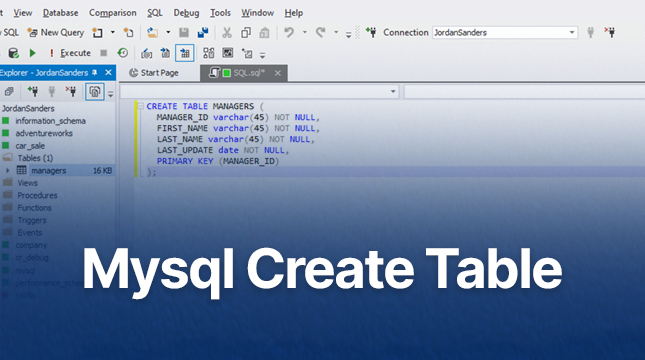How to Create Tables in MySQL? A Full Guide for Beginners

MySQL is a popular relational database management system used by developers and organizations worldwide. One of the fundamental operations you will frequently perform when working with MySQL is creating tables. Tables are the building blocks of a database, allowing you to store and organize data efficiently. In this article, we’ll walk you through everything you need to know about creating tables in MySQL, from the basics to advanced techniques.
Understanding MySQL
What is MySQL?
MySQL is an open-source relational database management system (RDBMS) that uses Structured Query Language (SQL) to manage and manipulate data. It’s known for its speed, reliability, and ease of use, making it a popular choice for web applications, data warehousing, and logging applications.
Benefits of Using MySQL
- Scalability: MySQL can handle large amounts of data and numerous concurrent users.
- Flexibility: It supports a wide range of data types and storage engines.
- Performance: MySQL is optimized for high-speed transactions.
- Security: It offers robust security features to protect data.
- Community Support: As an open-source platform, MySQL has a vast community of developers and users who contribute to its continuous improvement.
Getting Started with MySQL
Installing MySQL
Before creating tables, you need to have MySQL installed on your system. You can download the latest version of MySQL from the official website and follow the installation instructions for your operating system.
Setting Up the Environment
Once MySQL is installed, you need to set up your environment. This involves starting the MySQL server and accessing the MySQL command-line client or a graphical interface like MySQL Workbench.
Basic Concepts of MySQL Tables
What are Tables in MySQL?
Tables in MySQL are structured collections of data, organized into rows and columns. Each column represents a specific type of data (e.g., integers, strings, dates), while each row represents a single record.
Structure of a MySQL Table
A typical MySQL table consists of:
- Columns: Define the type of data each field will store.
- Rows: Each row is a record that contains data for each column.
- Constraints: Rules applied to columns to enforce data integrity.
Creating Your First Table
Syntax for Creating a Table
The basic syntax for creating a table in MySQL is:
CREATE TABLE table_name (
column1 datatype constraints,
column2 datatype constraints,
...
);
Example of Creating a Simple Table
Here’s an example of creating a simple table called users:
CREATE TABLE users (
id INT AUTO_INCREMENT,
username VARCHAR(50) NOT NULL,
email VARCHAR(100),
created_at TIMESTAMP DEFAULT CURRENT_TIMESTAMP,
PRIMARY KEY (id)
);
Defining Data Types
Common Data Types in MySQL
- INT: Integer values
- VARCHAR: Variable-length strings
- TEXT: Long text strings
- DATE: Date values
- TIMESTAMP: Date and time values
- BOOLEAN: True/False values
Choosing the Right Data Type
Selecting the appropriate data type is crucial for efficient storage and performance. Consider the nature of the data and how it will be used when choosing data types.
Adding Constraints
What are Constraints?
Constraints are rules applied to table columns to enforce data integrity and ensure accuracy. They include primary keys, foreign keys, unique constraints, not null constraints, and default values.
Types of Constraints
- Primary Key: Uniquely identifies each record.
- Foreign Key: Links records between tables.
- Unique: Ensures all values in a column are unique.
- Not Null: Ensures a column cannot have a null value.
- Default: Sets a default value for a column if no value is specified.
Creating Tables with Constraints
Example: Creating a Table with Primary Key and Unique Constraints
CREATE TABLE employees (
employee_id INT AUTO_INCREMENT,
employee_name VARCHAR(100) NOT NULL,
email VARCHAR(100) UNIQUE,
PRIMARY KEY (employee_id)
);
Example: Creating a Table with Foreign Key Constraints
CREATE TABLE orders (
order_id INT AUTO_INCREMENT,
order_date DATE,
customer_id INT,
PRIMARY KEY (order_id),
FOREIGN KEY (customer_id) REFERENCES customers(customer_id)
);
Advanced Table Creation Techniques
Using AUTO_INCREMENT
The AUTO_INCREMENT attribute automatically generates a unique number for each new record.
Setting Default Values
Default values can be set for columns to ensure a value is always provided.
CREATE TABLE products (
product_id INT AUTO_INCREMENT,
product_name VARCHAR(100) NOT NULL,
price DECIMAL(10, 2) DEFAULT 0.00,
PRIMARY KEY (product_id)
);
Modifying Existing Tables
Adding Columns
ALTER TABLE table_name ADD column_name datatype;
Modifying Columns
ALTER TABLE table_name MODIFY column_name new_datatype;
Dropping Columns
ALTER TABLE table_name DROP COLUMN column_name;
Deleting Tables
Syntax for Dropping Tables
DROP TABLE table_name;
Example of Dropping a Table
DROP TABLE old_data;
Best Practices for Creating Tables
Naming Conventions
Use clear and descriptive names for tables and columns. Avoid using reserved keywords.
Indexing for Performance
Indexes can significantly improve query performance. Consider indexing columns frequently used in search conditions.
Normalization Techniques
Normalization involves organizing data to reduce redundancy and improve data integrity. Follow standard normalization rules to design efficient databases.
Common Mistakes to Avoid
Using Reserved Keywords
Avoid using reserved SQL keywords as table or column names to prevent conflicts.
Ignoring Data Types
Incorrect data types can lead to inefficient storage and performance issues. Always choose the most appropriate data type.
Overlooking Constraints
Constraints help maintain data integrity. Ensure you use constraints effectively to enforce business rules.
Troubleshooting Table Creation Issues
Common Errors and Solutions
- Syntax Errors: Double-check your SQL syntax.
- Constraint Violations: Ensure data meets all constraint requirements.
- Data Type Mismatches: Verify data types are compatible with the data being stored.
Debugging Tips
- Read Error Messages: MySQL provides detailed error messages. Read them carefully to understand the issue.
- Test Queries Independently: Test complex queries step by step to isolate problems.
Conclusion
Creating tables in MySQL is a fundamental skill for anyone working with databases. Understanding the syntax, data types, constraints, and best practices will help you design efficient and reliable databases. Practice regularly to become proficient in table creation and management.

Let's Start Your Project
Get free consultation for your digital product idea to turn it into reality!
Get Started








